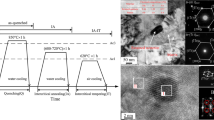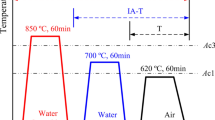Abstract
In this work, the effect of Cu addition on the microstructure and mechanical properties, in particular, low-temperature toughness, of low-carbon, high-strength steel was investigated. Steels with Cu concentrations varying from 1 to 2.5 wt pct in the place of carbon were prepared and then subjected to the two-step intercritical heat treatment. A mixed microstructure consisting of intercritical ferrite, tempered martensite, and retained austenite was obtained. There was an increased amount of retained austenite in the steels with Cu contents ranging from 0.23 to 2.5 wt pct. Therefore, Cu addition was beneficial for the stabilization of retained austenite. This phenomenon can be attributed to the enrichment of Cu in austenite and the increased driving force of reversed transformation caused by reduction in the T0 temperature (the temperature at which fcc austenite and bcc ferrite of identical composition have equal free energy). Furthermore, nanoscaled Cu precipitates were dispersed in the microstructure of Cu-containing steels. The combined effect of retained austenite and Cu precipitates could be the reason for excellent low-temperature toughness without loss in strength, which is featured by the impact energy of more than 120 J at 153 K (– 120 °C) for the Cu-containing steels. In addition to the deformation-induced transformation of retained austenite, bcc Cu precipitates act as misfit centers to improve the low-temperature toughness by enhancing the dislocation mobility and decreasing the ductile-to-brittle transformation temperature (DBTT).













Similar content being viewed by others
Notes
THERMO-CALC is trademark of Thermo-Calc Software, Norra Stationsgatan, Sweden.
INSTRON is trademark of Instron Co., Norwood, USA.
TECNAI is a trademark of FEI, Hillsboro, OR.
REFERENCES
S.W. Thompson: Mater. Sci. Eng. A, 2018, vol. 711, pp. 424–33.
T. Montemarano, B. Sack, and J. Gudas: J. Ship Prod. Des., 1986, vol. 2, p. 18.
S. Vaynman, D. Isheim, R. Prakash-Kolli, S.P. Bhat, D.N. Seidman, and M.E. Fine: Metall. Mater. Trans. A, 2008, vol. 39A, pp. 363–73.
G. Han, Z.J. Xie, L. Xiong, C.J. Shang, and R.D.K. Misra: Mater. Sci. Eng. A, 2017, vol. 705, pp. 89–97.
X.H. Yu, J.L. Caron, S.S. Babu, J.C. Lippold, D. Isheim, and D.N. Seidman: Acta Mater., 2010, vol. 58, pp. 5596–5609.
Y.U. Heo, Y.K. Kim, J.S. Kim, and J.K. Kim: Acta Mater., 2013, vol. 61, pp. 519–28.
Y.X. Zheng, F.M. Wang, C.R. Li, Y.L. Li, and J. Cheng: Mater. Sci. Eng. A, 2018, vol. 712, pp. 453–65.
S.K. Ghosh, A. Haldar, and P.P. Chattopadhyay: J. Mater. Sci., 2008, vol. 44, pp. 580–90.
K. Kunishige, T. Hashimoto, and T. Yukitoshi: Tetsu-to-Hagané, 1980, vol. 66, pp. 63–72.
K. Nakashima, Y. Futamura, T. Tsuchiyama, and S. Takaki: ISIJ Int., 2002, vol. 42, pp. 1541–45.
K. Nakashima, K. Imakawa, Y. Futamura, T. Tsuchiyama, and S. Takaki. Mater. Sci. Forum, 2004, vol. 467, pp. 905–10.
J.-Y. Kang, Y.-U. Heo, H. Kim, D.-W. Suh, D. Son, D.H. Lee, and T.-H. Lee: Mater. Sci. Eng. A, 2014, vol. 614, pp. 36–44.
J. Weertman: J Appl. Phys., 1958, vol. 29, p. 1685.
M. Fine, S. Vaynman, D. Isheim, Y. Chung, S. Bhat, and C. Hahin: Metall. Mater. Trans. A, 2010, vol. 41A, pp. 3318–25.
R. Song, D. Ponge, D. Raabe, J.G. Speer, and D.K. Matlock: Mater. Sci. Eng. A, 2006, vol. 441, pp. 1–17.
N. Nakada, J. Syarif, T. Tsuchiyama, and S. Takaki: Mater. Sci. Eng. A, 2004, vol. 374, pp. 137–44.
Z.B. Jiao, J.H. Luan, M.K. Miller, and C.T. Liu: Acta Mater., 2015, vol. 97, pp. 58–67.
K. Sugimoto, N. Usui, M. Kobayashi, and S. Hashimoto: ISIJ Int., 1992, vol. 32, pp. 1311–18.
R.D.K. Misra, Z. Jia, R. O’Malley, and S.J. Jansto: Mater. Sci. Eng. A, 2011, vol. 528, pp. 8772–80.
W.H. Zhou, H. Guo, Z.J. Xie, C.J. Shang, and R.D.K. Misra: Mater. Des., 2014, vol. 63, pp. 42–49.
W.H. Zhou, H. Guo, Z.J. Xie, X.M. Wang, and C.J. Shang: Mater. Sci. Eng. A, 2013, vol. 587, pp. 365–71.
Z.J. Xie, G. Han, W.H. Zhou, C.Y. Zeng, and C.J. Shang: Mater. Charact., 2016, vol. 113, pp. 60–66.
G. Salje and M. Feller-Kniepmeier: J. Appl. Phys., 1977, vol. 48, pp. 1833–39.
P. Cheng, B. Hu, S.L. Liu, H. Guo, M. Enomoto, and C.J. Shang: Mater. Sci. Eng. A, 2019, vol. 746, pp. 41–49.
C.F. Wang, M.Q. Wang, J. Shi, W.J. Hui, and H. Dong: Scripta Mater., 2008, vol. 58, pp. 492–95.
H.M. Flower and T.C. Lindley: Mater. Sci. Technol., 2013, vol. 16, pp. 26–40.
Z.J. Xie, Y.Q. Ren, W.H. Zhou, J.R. Yang, C.J. Shang, and R.D.K. Misra: Mater. Sci. Eng. A, 2014, vol. 603, pp. 69–75.
D.P. Yang, D. Wu, and H.L. Yi: Scripta Mater., 2019, vol. 161, pp. 1–5.
E. Rasanen: Scand. J. Metall., 1973, vol. 2, pp. 257–64.
A.R.H. Far, S.H.M. Anijdan, and S.M. Abbasi: Mater. Sci. Eng. A, 2019, vol. 746, pp. 384–93.
X.H. Xi, J.L. Wang, X. Li, L.Q. Chen, and Z.D. Wang: Metall. Mater. Trans. A, 2019, vol. 50A, pp. 2912–21.
J. Shi, X.J. Sun, M.Q. Wang, W.J. Hui, H. Dong, and W.Q. Cao: Scripta Mater., 2010, vol. 63, pp. 815–18.
T.L. Skoufari, D.N. Crowther, and B. Mintz: Mater. Sci. Technol., 1999, vol. 15, pp. 1069–79.
ACKNOWLEDGMENTS
This work is financially supported by the National Key Research and Development Program of China (13th Five-Year Plan) under Contract No. 2016YFB0300601.
Author information
Authors and Affiliations
Corresponding author
Additional information
Publisher's Note
Springer Nature remains neutral with regard to jurisdictional claims in published maps and institutional affiliations.
Manuscript submitted May 26, 2019.
Rights and permissions
About this article
Cite this article
Xi, X., Wang, J., Chen, L. et al. Understanding the Role of Copper Addition in Low-Temperature Toughness of Low-Carbon, High-Strength Steel. Metall Mater Trans A 50, 5627–5639 (2019). https://doi.org/10.1007/s11661-019-05462-z
Received:
Published:
Issue Date:
DOI: https://doi.org/10.1007/s11661-019-05462-z




